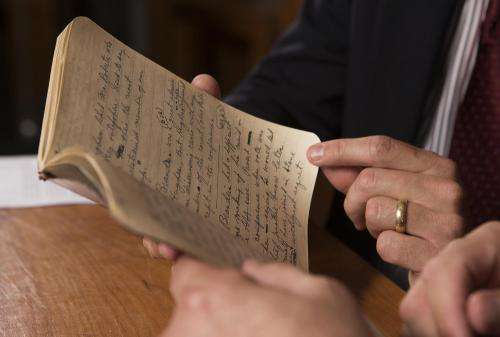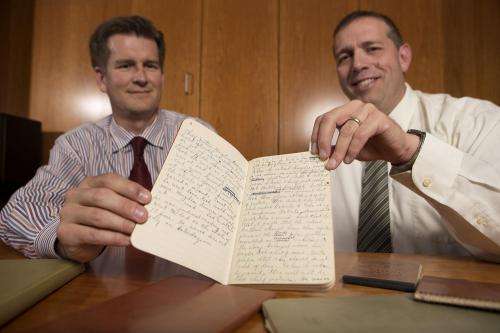Supreme Court mystery unlocked from BYU's vaults 75 years later

(Phys.org)—The explanation for a Supreme Court justice's motivations in one of the most mysterious and important decisions in U.S. history has been hiding deep in the vaults of BYU's Special Collections.
It's been tucked away for decades, but no one knew it until now.
This spring, communications professor Ed Carter unearthed the key to the mystery while digging through materials from the late Merlo J. Pusey, a Mormon Pulitzer Prize-winning journalist.
"I came upon a notebook marked 'Confidential' and, obviously, I got excited," Carter said. "I wanted to find out what was in that notebook that Pusey didn't want to have publicly known."
The unpublished notes of an interview with Justice Owen J. Roberts provide a previously unknown account for a landmark, left-shifting 1937 vote by the conservative Roberts. The vote is credited with subduing President Franklin Delano Roosevelt's threat to increase the court to as many as 15 judges in order to move forward his New Deal legislation.
It's called "the switch in time that saved nine," and it's a phrase legal scholars, lawyers and judicial junkies have long been familiar with.
"It's just a marvelous, enormously important find," said University of Michigan law professor Richard D. Friedman, a Supreme Court history expert. "When Professor Carter sent the notes to me, I had a lot of work I should have been doing, but instead I read through the notes with great interest. It was just fascinating. I'm jealous because I wish I had found them."

Many scholars presume Owen Roberts shifted on the case in question simply to appease FDR and keep him from meddling with the court. In fact, Roberts' only previously known public statements gave purely legal reasons. But Pusey's notes from a May 21, 1946, interview with Roberts indicate he had mixed motivations involving political, strategic and legal considerations.
"Roberts did not wilt under political pressure from Roosevelt, but he also did not ignore public opinions and circumstances," Carter said. "Roberts recognized that being set apart from politics does not mean being ignorant of contemporary events and attitudes."
Pusey's notes indicate Roberts' switch may have been influenced more by non-political factors.
"It is difficult to say what makes a judge decide as he does," Roberts says, according to Pusey. "Public outcry against an opinion is bound to have some effect on a man's thinking when it is a question of degree – of how far we can go."
Carter and fellow communications professor Ed Adams detail the contents of the Pusey notes and the implications of the revelations in the current issue of legal journal The Green Bag.
Carter said he wasn't looking for anything in particular when he started digging through Pusey's boxes, but just "got lucky."
Pusey, an editorial writer for the Washington Post from 1928 to 1971, interviewed Roberts for his Pulitzer Prize-winning biography of Chief Justice Charles Evans Hughes, whom Roberts served with on the court.
Pusey grew up in Woodruff, Utah, but spent most of his professional life in Washington D.C. He did maintain connections to Utah, and was once offered a job as a journalism professor by former BYU President Ernest L. Wilkinson. He donated materials to BYU's library prior to his death in 1985.
Though he wasn't overtly Mormon in his writing, Pusey's faith influenced him, Carter said. In fact, he served as the ward historian in the Chevy Chase Ward in Maryland.
Carter and Adams believe there is much more to be found in Pusey's archives and plan to publish additional research in the months to come.
"I think people will study these [notes] for some time," Friedman said. "It really is a historian's dream."
Provided by Brigham Young University


















